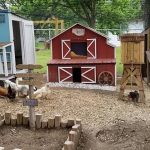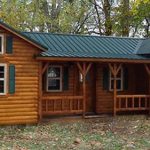He Survived 30 Years Alone In The Alaskan Wilderness
Have you ever thought of leaving everything and starting your life anew somewhere in the wilderness? The thought is terrifying at first, but several advantages of such a life will soon pop up, I am sure.
Has it become tempting already? Wait… One has to be determined to say goodbye to the comforts and luxuries of modern life.
Yet, some people are prepared to make this move and enjoy their lives isolated from the rest of the world.
In 1968, then 52-year-old Dick Proenneke, a former mechanic and heavy equipment operator, moved to the Alaskan wilderness and lived there alone for thirty years.
The skillful man spotted a shoreside spot in the area now known as Lake Clark National Park and Preserve, and started building a 12-by-16 foot cabin using only simple tools, and local materials like trees, stones, and moss.
He brought in steel parts and made the handles with local wood. When his tools broke, he repaired them instead of buying new ones.
His cabin eventually got windows, a Dutch door, a fireplace, and a waterproof moss-covered roof. Dick also built a cache to keep his food storage out of animals’ reach.
His remarkable cabin is a unique one in the Alaskan Bush, as it is a result of his remarkable craftsmanship. Using a small camera and a tripod, he filmed the construction of the cabin and documented much of the local wildlife.
He survived with no electricity, running water, telephone, or wi-fi. Brave bush pilots flew in food items and other supplies every couple of weeks. He lived a happy life there, always busy, hiking thousands of miles every year in the wilderness.
Proenneke once noted that he was so busy with his life that he was never lonely. Being an obsessive observer and diarist, he wrote about the weather, the environment, and the animals during most of his time.
In 1999, he left his cabin to live in California with his brother as he was too elderly to live in isolation. He passed away in 2003.
Yet, he taught the world a lot of valuable lessons. In his book, One Man’s Wilderness, he wrote:
“I have found that some of the simplest things have given me the most pleasure. They didn’t cost me a lot of money either. They just worked on my senses. Did you ever pick very large blueberries after a summer rain?
Walk through a grove of cottonwoods, open like a park, and see the blue sky beyond the shimmering gold of the leaves? Pull on dry woolen socks after you’ve peeled off the wet ones? Come in out of the subzero and shiver yourself warm in front of a wood fire? The world is full of such things.”
He was constantly writing about his experiences in his journals, and he thus learned to appreciate nature, to be grateful, and to be satisfied with his life.
His simple life made him indifferent to material things, and grateful for the little things he had:
“Needs? I guess that is what bothers so many folks. They keep expanding their needs until they are dependent on too many things and too many other people…
I wonder how many things in the average American home could be eliminated if the question were asked, “Must I really have this?” I guess most of the extras are chalked up to comfort or saving time. ”
He fell in love with nature and the environment, and the formerly self-described “trigger happy hunter” changed a lot after his life in the wilderness. He took only as much as he needed, in contrast to our society, that revolves around excess.
A friend of Proenneke compiled his journals and published a book titled “One Man’s Wilderness: An Alaskan Odyssey” in 1973.
Since then, his self-recorder videos have been turned into four one-hour documentaries that reveal his life and survival in the Alaskan wilderness.
When he moved to California, Dick left his cabin as a gift to the National Park Service, and people can visit it in the summer at Lake Clark National Park and Preserve.
Together with the outbuildings, it was listed on the National Register of Historic Places in 2007.
It is nationally recognized as a great example of an Alaskan bush log cabin. The cabin also stands as a symbol of the mission of Richard Proenneke to point out the importance of the preservation of the Alaskan wilderness and the conservation of our natural world.
Partly due to his conservation efforts, Twin Lakes and Lake Clark National Park remain much the same as it did when the ultimate Alaskan adventurer dwelled in the land.




Leave a Reply